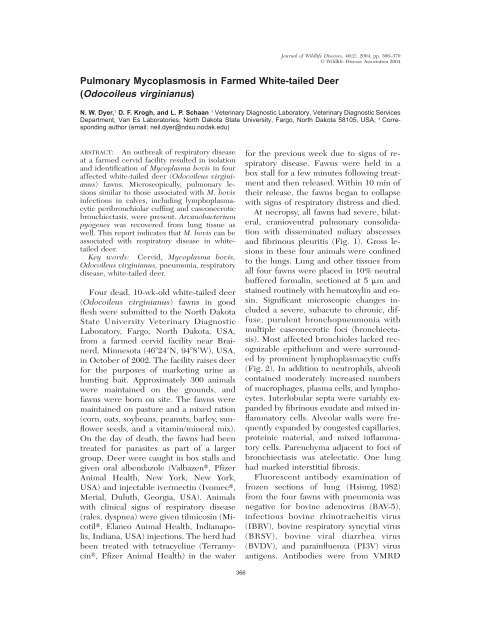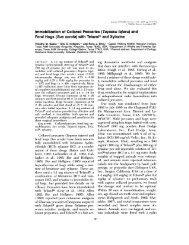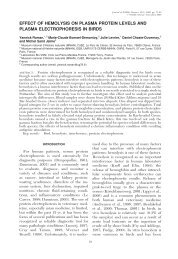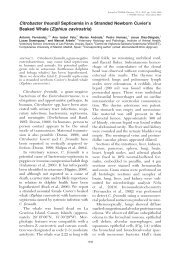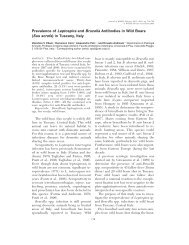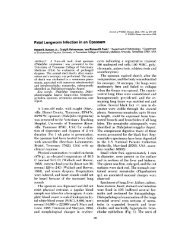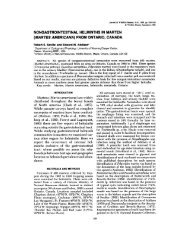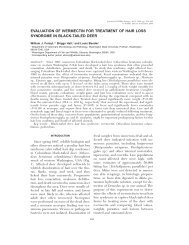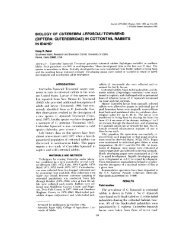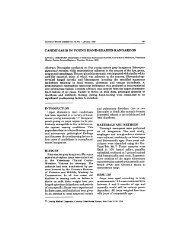Pulmonary Mycoplasmosis in Farmed White-tailed Deer - Journal of ...
Pulmonary Mycoplasmosis in Farmed White-tailed Deer - Journal of ...
Pulmonary Mycoplasmosis in Farmed White-tailed Deer - Journal of ...
You also want an ePaper? Increase the reach of your titles
YUMPU automatically turns print PDFs into web optimized ePapers that Google loves.
<strong>Pulmonary</strong> <strong>Mycoplasmosis</strong> <strong>in</strong> <strong>Farmed</strong> <strong>White</strong>-<strong>tailed</strong> <strong>Deer</strong><br />
(Odocoileus virg<strong>in</strong>ianus)<br />
366<br />
<strong>Journal</strong> <strong>of</strong> Wildlife Diseases, 40(2), 2004, pp. 366–370<br />
Wildlife Disease Association 2004<br />
N. W. Dyer, 1 D. F. Krogh, and L. P. Schaan 1 Veter<strong>in</strong>ary Diagnostic Laboratory, Veter<strong>in</strong>ary Diagnostic Services<br />
Department, Van Es Laboratories, North Dakota State University, Fargo, North Dakota 58105, USA; 1 Correspond<strong>in</strong>g<br />
author (email: neil.dyer@ndsu.nodak.edu)<br />
ABSTRACT: An outbreak <strong>of</strong> respiratory disease<br />
at a farmed cervid facility resulted <strong>in</strong> isolation<br />
and identification <strong>of</strong> Mycoplasma bovis <strong>in</strong> four<br />
affected white-<strong>tailed</strong> deer (Odocoileus virg<strong>in</strong>ianus)<br />
fawns. Microscopically, pulmonary lesions<br />
similar to those associated with M. bovis<br />
<strong>in</strong>fections <strong>in</strong> calves, <strong>in</strong>clud<strong>in</strong>g lymphoplasmacytic<br />
peribronchiolar cuff<strong>in</strong>g and caseonecrotic<br />
bronchiectasis, were present. Arcanobacterium<br />
pyogenes was recovered from lung tissue as<br />
well. This report <strong>in</strong>dicates that M. bovis can be<br />
associated with respiratory disease <strong>in</strong> white<strong>tailed</strong><br />
deer.<br />
Key words: Cervid, Mycoplasma bovis,<br />
Odocoileus virg<strong>in</strong>ianus, pneumonia, respiratory<br />
disease, white-<strong>tailed</strong> deer.<br />
Four dead, 10-wk-old white-<strong>tailed</strong> deer<br />
(Odocoileus virg<strong>in</strong>ianus) fawns <strong>in</strong> good<br />
flesh were submitted to the North Dakota<br />
State University Veter<strong>in</strong>ary Diagnostic<br />
Laboratory, Fargo, North Dakota, USA,<br />
from a farmed cervid facility near Bra<strong>in</strong>erd,<br />
M<strong>in</strong>nesota (4624N, 948W), USA,<br />
<strong>in</strong> October <strong>of</strong> 2002. The facility raises deer<br />
for the purposes <strong>of</strong> market<strong>in</strong>g ur<strong>in</strong>e as<br />
hunt<strong>in</strong>g bait. Approximately 300 animals<br />
were ma<strong>in</strong>ta<strong>in</strong>ed on the grounds, and<br />
fawns were born on site. The fawns were<br />
ma<strong>in</strong>ta<strong>in</strong>ed on pasture and a mixed ration<br />
(corn, oats, soybeans, peanuts, barley, sunflower<br />
seeds, and a vitam<strong>in</strong>/m<strong>in</strong>eral mix).<br />
On the day <strong>of</strong> death, the fawns had been<br />
treated for parasites as part <strong>of</strong> a larger<br />
group. <strong>Deer</strong> were caught <strong>in</strong> box stalls and<br />
given oral albendazole (Valbazen, Pfizer<br />
Animal Health, New York, New York,<br />
USA) and <strong>in</strong>jectable ivermect<strong>in</strong> (Ivomec,<br />
Merial, Duluth, Georgia, USA). Animals<br />
with cl<strong>in</strong>ical signs <strong>of</strong> respiratory disease<br />
(rales, dyspnea) were given tilmicos<strong>in</strong> (Micotil,<br />
Elanco Animal Health, Indianapolis,<br />
Indiana, USA) <strong>in</strong>jections. The herd had<br />
been treated with tetracycl<strong>in</strong>e (Terramyc<strong>in</strong>,<br />
Pfizer Animal Health) <strong>in</strong> the water<br />
for the previous week due to signs <strong>of</strong> respiratory<br />
disease. Fawns were held <strong>in</strong> a<br />
box stall for a few m<strong>in</strong>utes follow<strong>in</strong>g treatment<br />
and then released. With<strong>in</strong> 10 m<strong>in</strong> <strong>of</strong><br />
their release, the fawns began to collapse<br />
with signs <strong>of</strong> respiratory distress and died.<br />
At necropsy, all fawns had severe, bilateral,<br />
cranioventral pulmonary consolidation<br />
with dissem<strong>in</strong>ated miliary abscesses<br />
and fibr<strong>in</strong>ous pleuritis (Fig. 1). Gross lesions<br />
<strong>in</strong> these four animals were conf<strong>in</strong>ed<br />
to the lungs. Lung and other tissues from<br />
all four fawns were placed <strong>in</strong> 10% neutral<br />
buffered formal<strong>in</strong>, sectioned at 5 m and<br />
sta<strong>in</strong>ed rout<strong>in</strong>ely with hematoxyl<strong>in</strong> and eos<strong>in</strong>.<br />
Significant microscopic changes <strong>in</strong>cluded<br />
a severe, subacute to chronic, diffuse,<br />
purulent bronchopneumonia with<br />
multiple caseonecrotic foci (bronchiectasis).<br />
Most affected bronchioles lacked recognizable<br />
epithelium and were surrounded<br />
by prom<strong>in</strong>ent lymphoplasmacytic cuffs<br />
(Fig. 2). In addition to neutrophils, alveoli<br />
conta<strong>in</strong>ed moderately <strong>in</strong>creased numbers<br />
<strong>of</strong> macrophages, plasma cells, and lymphocytes.<br />
Interlobular septa were variably expanded<br />
by fibr<strong>in</strong>ous exudate and mixed <strong>in</strong>flammatory<br />
cells. Alveolar walls were frequently<br />
expanded by congested capillaries,<br />
prote<strong>in</strong>ic material, and mixed <strong>in</strong>flammatory<br />
cells. Parenchyma adjacent to foci <strong>of</strong><br />
bronchiectasis was atelectatic. One lung<br />
had marked <strong>in</strong>terstitial fibrosis.<br />
Fluorescent antibody exam<strong>in</strong>ation <strong>of</strong><br />
frozen sections <strong>of</strong> lung (Hsiung, 1982)<br />
from the four fawns with pneumonia was<br />
negative for bov<strong>in</strong>e adenovirus (BAV-5),<br />
<strong>in</strong>fectious bov<strong>in</strong>e rh<strong>in</strong>otracheitis virus<br />
(IBRV), bov<strong>in</strong>e respiratory syncytial virus<br />
(BRSV), bov<strong>in</strong>e viral diarrhea virus<br />
(BVDV), and para<strong>in</strong>fluenza (PI3V) virus<br />
antigens. Antibodies were from VMRD
SHORT COMMUNICATIONS 367<br />
FIGURE 1. Severe bronchopneumonia <strong>in</strong> a white-<strong>tailed</strong> deer (Odocoileus virg<strong>in</strong>ianus) fawn. Note the l<strong>in</strong>e<br />
<strong>of</strong> demarcation (arrows) between the consolidated and non-consolidated lung. H heart.<br />
(Pullman, Wash<strong>in</strong>gton, USA; BAV-5) and<br />
USDA (National Veter<strong>in</strong>ary Services Laboratory,<br />
Reagents Office, Ames, Iowa,<br />
USA; BRSV, BVDV, IBRV, PI3V, and<br />
BRSV). Lung tissue from these four fawns<br />
was submitted for bacterial culture. Samples<br />
were placed on TSA II 5% sheep<br />
blood (Becton Dick<strong>in</strong>son, Sparks, Maryland,<br />
USA) at O 2,5%CO 2 and 15% CO 2,<br />
and MacConkey II (Becton Dick<strong>in</strong>son) at<br />
O 2, bra<strong>in</strong> heart <strong>in</strong>fusion broth (Becton<br />
Dick<strong>in</strong>son) at O 2 and Mycoplasma agar<br />
(Myco Plate, Vet Med Biological Media<br />
Services, UCD, Davis, California, USA) at<br />
5% CO 2. Plates and broth were <strong>in</strong>cubated<br />
<strong>in</strong> a moist chamber at 37 C. Arcanobacterium<br />
pyogenes (high numbers) and<br />
Escherichia coli (low numbers) were recovered<br />
from all four deer after 24 hr <strong>of</strong><br />
<strong>in</strong>cubation. At 48 hr, Mycoplasma plates<br />
exam<strong>in</strong>ed under an <strong>in</strong>verted microscope<br />
(10) showed typical fried-egg colonies.<br />
The Mycoplasma organism was submitted<br />
to a reference laboratory (California Ani-<br />
mal Health and Food Safety Laboratory<br />
System, Tulare, California, USA) for speciation<br />
and was subsequently identified<br />
(immun<strong>of</strong>luorescence; Baas and Jasper,<br />
1972) as M. bovis. Replicate sections <strong>of</strong><br />
lung tissue from each fawn exam<strong>in</strong>ed with<br />
M. bovis–specific antibody by immunohistochemistry<br />
(Ha<strong>in</strong>es et al., 2001) at a reference<br />
laboratory (Prairie Diagnostic Services,<br />
Saskatoon, Saskatchewan, Canada)<br />
were found to be positive.<br />
Mycoplasma bovis is a recognized cause<br />
<strong>of</strong> calf pneumonia worldwide. Lesions <strong>in</strong><br />
naturally affected calves are described as<br />
an exudative bronchopneumonia with foci<br />
<strong>of</strong> coagulative necrosis that are surrounded<br />
by mixed <strong>in</strong>flammatory cells, whereas experimentally<br />
<strong>in</strong>fected calves had purulent<br />
bronchitis with peribronchiolar mononuclear<br />
cell cuffs (Brys et al., 1989; Rodriquez<br />
et al., 1996). In naturally <strong>in</strong>fected<br />
calves, antigen was demonstrated around<br />
foci <strong>of</strong> coagulation necrosis, <strong>in</strong> necrotic exudate,<br />
and with<strong>in</strong> phagocytic cells, while
368 JOURNAL OF WILDLIFE DISEASES, VOL. 40, NO. 2, APRIL 2004<br />
FIGURE 2. Mycoplasma bovis pneumonia <strong>in</strong> a white-<strong>tailed</strong> deer (Odocoileus virg<strong>in</strong>ianus) fawn. Note the<br />
caseonecrotic bronchiectasis (B) and lymphoplasmacytic peribronchiolar cuff (zone between arrows) surround<strong>in</strong>g<br />
the affected airway. Bar200 m.<br />
<strong>in</strong> experimentally <strong>in</strong>fected animals antigen<br />
was found <strong>in</strong> airway epithelial cells, <strong>in</strong>flammatory<br />
cells, and alveolar walls (Adeboye<br />
et al., 1995). In the fawns, M. bovis antigen<br />
was detected <strong>in</strong> caseonecrotic foci associated<br />
with bronchiectasis, both <strong>in</strong> lum<strong>in</strong>al<br />
exudate and rema<strong>in</strong><strong>in</strong>g epithelial<br />
cells, which is consistent with f<strong>in</strong>d<strong>in</strong>gs <strong>in</strong><br />
naturally <strong>in</strong>fected calves.<br />
Pyogranulomatous synovitis, tenosynovitis,<br />
periarthritis, and otitis have been associated<br />
with M. bovis pneumonia <strong>in</strong><br />
calves and feedlot cattle (Adeboye et al.,<br />
1996; Walz et al., 1997; Ha<strong>in</strong>es et al.,<br />
2001); however, such lesions were not observed<br />
<strong>in</strong> these deer. Studies <strong>in</strong> calves experimentally<br />
<strong>in</strong>fected with both M. bovis<br />
and BRSV found no <strong>in</strong>crease <strong>in</strong> the severity<br />
<strong>of</strong> lesions <strong>in</strong> co<strong>in</strong>fected calves (Thomas<br />
et al., 1986). A co<strong>in</strong>fection with Mannheimia<br />
hemolytica <strong>in</strong>duced a moderate <strong>in</strong>crease<br />
<strong>in</strong> lesion severity (Gourlay and<br />
Houghton, 1995) but only when calves<br />
were <strong>in</strong>fected with M. bovis 24 hr prior to<br />
<strong>in</strong>fection with M. hemolytica. Mycoplasma<br />
bovis pneumonia <strong>in</strong> calves is typically more<br />
severe when multiple pathogens, particularly<br />
M. hemolytica, Pasteurella multocida,<br />
and Hemophilus somnus, are <strong>in</strong>volved (Bucharova<br />
and Vessel<strong>in</strong>ova, 1989). Studies<br />
us<strong>in</strong>g Mycoplasma dispar <strong>in</strong>dicate the<br />
pathogenesis <strong>of</strong> Mycoplasma pneumonia<br />
<strong>in</strong> calves <strong>in</strong>volves degeneration and impairment<br />
<strong>of</strong> ciliated respiratory epithelial<br />
cells, thereby predispos<strong>in</strong>g the lung to secondary<br />
<strong>in</strong>fection with additional pathogens<br />
(Almeida and Rosenbusch, 1994).<br />
Pneumonia caused by M. bovis has not<br />
previously been reported <strong>in</strong> white-<strong>tailed</strong><br />
deer (Whithear, 2001). A report <strong>of</strong> Mycoplasma<br />
pneumonia <strong>in</strong> a Thomson’s gazelle<br />
(Gazella thomsoni) described the microscopic<br />
changes as a ‘‘cuff<strong>in</strong>g pneumonia’’<br />
(Watson and Slocombe, 1986). Arcanobac-
terium pyogenes has been associated with<br />
disease <strong>in</strong> white-<strong>tailed</strong> deer and was isolated<br />
from animals with <strong>in</strong>tracranial abscesses<br />
and men<strong>in</strong>goencephalitis (Davidson<br />
et al., 1990; Bauman et al., 2001). A<br />
recent case report <strong>of</strong> A. pyogenes septicemia<br />
<strong>in</strong> white-<strong>tailed</strong> deer de<strong>tailed</strong> similar<br />
but more severe lung lesions than were<br />
seen <strong>in</strong> these fawns (Turnquist and Fales,<br />
1998). Studies <strong>in</strong> calves have associated M.<br />
bovis with respiratory disease outbreaks <strong>of</strong><br />
<strong>in</strong>creased severity (Gourlay et al., 1989).<br />
Based on the characteristic Mycoplasmaassociated<br />
lesions seen <strong>in</strong> these fawns, it is<br />
likely the pneumonia was more severe due<br />
to the synergistic effect <strong>of</strong> M. bovis and A.<br />
pyogenes. The peracute death <strong>of</strong> the fawns<br />
can be attributed to the severe pulmonary<br />
lesions and stress associated with handl<strong>in</strong>g.<br />
Even though FA exam<strong>in</strong>ations for viruses<br />
were negative, a possible predispos<strong>in</strong>g viral<br />
<strong>in</strong>fection cannot be elim<strong>in</strong>ated. Serosurveys<br />
for bov<strong>in</strong>e viral agents conducted<br />
on North American white-<strong>tailed</strong> deer (Ingebrigtsen<br />
et al., 1986; Sadi et al., 1991)<br />
report seroconversion, but provide little<br />
<strong>in</strong>formation on actual disease caused by<br />
these agents. Systemic adenovirus <strong>in</strong>fection<br />
is well-described <strong>in</strong> mule deer (Odocoileus<br />
hemionus) (Woods et al., 1996),<br />
black-<strong>tailed</strong> deer (Odocoileus hemionus<br />
columbianus) (Woods et al., 1999), and<br />
white-<strong>tailed</strong> deer (Sorden et al., 2000;<br />
Woods et al., 2001); however, the reported<br />
lesions <strong>of</strong> pulmonary edema, hemorrhagic<br />
enteropathy, and vasculitis along with typical<br />
viral <strong>in</strong>clusion bodies were not observed<br />
<strong>in</strong> these fawns. Immunohistochemistry<br />
and virus isolation for adenovirus was<br />
not attempted. A def<strong>in</strong>itive means <strong>of</strong> exposure<br />
to the Mycoplasma organism was<br />
not established. The premises are fully<br />
fenced, but nose-to-nose contact with wild<br />
deer is possible. The nearest cattle are<br />
separated by a gravel road. Certa<strong>in</strong>ly, any<br />
animals <strong>in</strong>troduced to the herd could represent<br />
sources <strong>of</strong> M. bovis <strong>in</strong>fection. This<br />
case <strong>in</strong>dicates that M. bovis can be associated<br />
with severe respiratory disease <strong>in</strong><br />
white-<strong>tailed</strong> deer and should be a patho-<br />
SHORT COMMUNICATIONS 369<br />
gen <strong>of</strong> consideration <strong>in</strong> wildlife and the<br />
farmed cervid <strong>in</strong>dustry.<br />
LITERATURE CITED<br />
ADEBOYE, D. S., P. G. HALBUR, D.L.CAVANAUGH,<br />
R. E. WERDIN, C.C.CHASE, D.W.MISKIMINS,<br />
AND R. F. ROSENBUSCH. 1995. Immunohistochemical<br />
and pathological study <strong>of</strong> Mycoplasma<br />
bovis-associated lung abscesses <strong>in</strong> calves. <strong>Journal</strong><br />
<strong>of</strong> Veter<strong>in</strong>ary Diagnostic Investigation 7: 333–<br />
337.<br />
, ,R.G.NUTSCH, R.G.KADLEC, AND<br />
R. F. ROSENBUSCH. 1996. Mycoplasma bovis-associated<br />
pneumonia and arthritis complicated<br />
with pyogranulomatous tenosynovitis <strong>in</strong> calves.<br />
<strong>Journal</strong> <strong>of</strong> the American Veter<strong>in</strong>ary Medical Association<br />
209: 647–649.<br />
ALMEIDA, R.A.,AND R. F. ROSENBUSCH. 1994. Impaired<br />
tracheobronchial clearance <strong>of</strong> bacteria <strong>in</strong><br />
calves <strong>in</strong>fected with Mycoplasma dispar. Zentralblatt<br />
fur Veter<strong>in</strong>armediz<strong>in</strong> 41: 473–482.<br />
BAAS, E.J.,AND D. E. JASPER. 1972. Agar block technique<br />
for identification <strong>of</strong> mycoplasms by use <strong>of</strong><br />
fluorescent antibody. Applied Microbiology 23:<br />
1097–1100.<br />
BAUMANN, C. D., W. R. DAVIDSON, D.E.ROSCOE,<br />
AND K. BEHELER-AMASS. 2001. Intracranial abscessation<br />
<strong>in</strong> white-<strong>tailed</strong> deer <strong>of</strong> North America.<br />
<strong>Journal</strong> <strong>of</strong> Wildlife Diseases 37: 661–670.<br />
BRYS, A., H. GUNTHER, AND D. SCHIMMEL. 1989.<br />
Experimental Mycoplasma bovis <strong>in</strong>fection <strong>of</strong> the<br />
respiratory tract <strong>of</strong> calves. Archiv fur Experimentelle<br />
Veter<strong>in</strong>armediz<strong>in</strong> 43: 667–676.<br />
BUCHVAROVA, Y., AND A. VESSELINOVA. 1989. On<br />
the aetiopathogenesis <strong>of</strong> Mycoplasma pneumonia<br />
<strong>in</strong> calves. Archiv fur Experimentelle Veter<strong>in</strong>armediz<strong>in</strong><br />
43: 685–689.<br />
DAVIDSON, W. R., V. F. NETTLES, L.E.HAYES, E.W.<br />
HOWERTH, AND C. E. COUVILLION. 1990. Epidemiologic<br />
features <strong>of</strong> an <strong>in</strong>tracranial abscessation/suppurative<br />
men<strong>in</strong>goencephalitis complex <strong>in</strong><br />
white-<strong>tailed</strong> deer. <strong>Journal</strong> <strong>of</strong> Wildlife Diseases<br />
26: 460–467.<br />
GOURLAY, R.N., AND S. B. HOUGHTON. 1995. Experimental<br />
pneumonia <strong>in</strong> conventionally reared<br />
and gnotobiotic calves by dual <strong>in</strong>fection with Mycoplasma<br />
bovis and Pasteurella haemolytica. Research<br />
<strong>in</strong> Veter<strong>in</strong>ary Science 38: 377–382.<br />
,L.H.THOMAS, AND S. G. WYLD. 1989. Increased<br />
severity <strong>of</strong> calf pneumonia associated<br />
with appearance <strong>of</strong> Mycoplasma bovis <strong>in</strong> a rear<strong>in</strong>g<br />
herd. The Veter<strong>in</strong>ary Record 124: 420–422.<br />
HAINES, D. B., K. M. MARGIN, E.G.CLARK, G.K.<br />
JIM, AND E. D. JANZEN. 2001. The immunohistochemical<br />
detection <strong>of</strong> Mycoplasma bovis and<br />
bov<strong>in</strong>e viral diarrhea virus <strong>in</strong> tissues <strong>of</strong> feedlot<br />
cattle with chronic, unresponsive respiratory disease<br />
and/or arthritis. Canadian Veter<strong>in</strong>ary <strong>Journal</strong><br />
42: 857–860.
370 JOURNAL OF WILDLIFE DISEASES, VOL. 40, NO. 2, APRIL 2004<br />
HSIUNG, G. D. 1982. Diagnostic virology, 3rd Edition,<br />
Yale University Press, New Haven, Conecticut,<br />
pp. 60–61.<br />
INGEBRIGSTEN, D. K., J. R. LUDWIG, AND A. W.<br />
MCCLURKIN. 1986. Occurrence <strong>of</strong> antibodies to<br />
the etiologic agents <strong>of</strong> <strong>in</strong>fectious bov<strong>in</strong>e rh<strong>in</strong>otracheitis,<br />
para<strong>in</strong>fluenza 3, leptospirosis, and brucellosis<br />
<strong>in</strong> white-<strong>tailed</strong> deer <strong>in</strong> M<strong>in</strong>nesota. <strong>Journal</strong><br />
<strong>of</strong> Wildlife Diseases 22: 83–86.<br />
RODRIQUEZ, F., D. G. BRYSON, H.J.BALL, AND F.<br />
FORSTER. 1996. Pathological and immunohistochemical<br />
studies <strong>of</strong> natural and experimental<br />
Mycoplasma bovis pneumonia <strong>in</strong> calves. <strong>Journal</strong><br />
<strong>of</strong> Comparative Pathology 115: 151–162.<br />
SADI, L., R. JOYAL, M.ST.-GEORGES, AND L. LA-<br />
MONTAGNE. 1991. Serologic survey <strong>of</strong> white<strong>tailed</strong><br />
deer on Anticosti Island, Quebec, for bov<strong>in</strong>e<br />
herpesvirus 1, bov<strong>in</strong>e viral diarrhea, and<br />
para<strong>in</strong>fluenza 3. <strong>Journal</strong> <strong>of</strong> Wildlife Diseases 27:<br />
569–577.<br />
SORDEN, S. D., L. W. WOODS, AND H. D. LEHM-<br />
KUHL. 2000. Fatal pulmonary edema <strong>in</strong> white<strong>tailed</strong><br />
deer (Odocoileus virg<strong>in</strong>ianus) associated<br />
with adenovirus <strong>in</strong>fection. <strong>Journal</strong> <strong>of</strong> Veter<strong>in</strong>ary<br />
Diagnostic Investigation 12: 378–380.<br />
THOMAS, L. H., C. J. HOWARD, E.J.SCOTT, AND K.<br />
R. PARSONS. 1986. Mycoplasma bovis <strong>in</strong>fection<br />
<strong>in</strong> gnotobiotic calves and comb<strong>in</strong>ed <strong>in</strong>fection<br />
with respiratory syncytial virus. Veter<strong>in</strong>ary Pathology<br />
23: 571–578.<br />
TURNQUIST, S.E.,AND W. H. FALES. 1998. Act<strong>in</strong>omyces<br />
pyogenes <strong>in</strong>fection <strong>in</strong> a free-rang<strong>in</strong>g white<strong>tailed</strong><br />
deer. <strong>Journal</strong> <strong>of</strong> Veter<strong>in</strong>ary Diagnostic Investigation<br />
10: 86–89.<br />
WALZ, P. H., T. P. MULLANEY, J.A.RENDER, R.D.<br />
WALKER, T.MOSSER, AND J. C. BAKER. 1997.<br />
Otitis media <strong>in</strong> preweaned Holste<strong>in</strong> dairy calves<br />
<strong>in</strong> Michigan due to Mycoplasma bovis. <strong>Journal</strong><br />
<strong>of</strong> Veter<strong>in</strong>ary Diagnostic Investigation 9: 250–<br />
254.<br />
WATSON, G. L., AND R. F. SLOCOMBE. 1986. <strong>Mycoplasmosis</strong><br />
<strong>in</strong> a Thomson’s gazelle. Veter<strong>in</strong>ary<br />
Pathology 23: 329–331.<br />
WHITHEAR, K. G. 2001. Diseases due to mycoplasmas.<br />
In Infectious diseases <strong>of</strong> wild mammals, 3rd<br />
Edition, E. S. Williams and I. K. Barker (eds.).<br />
Iowa State University Press, Ames, Iowa, pp.<br />
413–422.<br />
WOODS, L. W., P. K. SWIFT, B.C.BARR, M.C.HOR-<br />
ZINEK, R.W.NORDHAUSEN, M.H.STILLIAN, J.<br />
F. PATTON, M.N.OLIVER, K.R.JONES, AND N.<br />
J. MACLACHLAN. 1996. Systemic adenovirus <strong>in</strong>fection<br />
associated with high mortality <strong>in</strong> mule<br />
deer (Odocoileus hemonius) <strong>in</strong> California. Veter<strong>in</strong>ary<br />
Pathology 33: 125–132.<br />
,R.S.HANLEY, P.H.CHIUR, H.D.LEHM-<br />
KUHL, R.W.NORDHAUSERN, M.H.STILLIAN,<br />
AND P. K. SWIFT. 1999. Lesions and transmission<br />
<strong>of</strong> experimental adenovirus hemorrhagic disease<br />
<strong>in</strong> black-<strong>tailed</strong> deer fawns. Veter<strong>in</strong>ary Pathology<br />
36: 100–110.<br />
,H.D.LEHMKUHL, P.K.SWIFT, P.H.CHIU,<br />
R. S. HANLEY, R.W.NORDHAUSEN, M.H.STIL-<br />
LIAN, AND M. L. DREW. 2001. Experimental adenovirus<br />
hemorrhagic disease <strong>in</strong> white-<strong>tailed</strong><br />
deer fawns. <strong>Journal</strong> <strong>of</strong> Wildlife Diseases 37: 153–<br />
158.<br />
Received for publication 9 June 2003.


